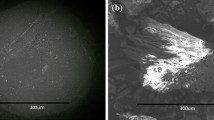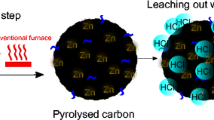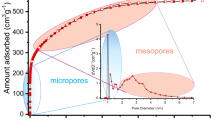Abstract
The paper deals with a comparative study of equilibrium and kinetics of phenol adsorption from aqueous solutions by means of commercial activated carbons and semi-cokes, differing in the nature of feedstock, production technology and structural characteristics. The main adsorption parameters are calculated with the usage of Langmuir and Dubinin–Radushkevich equations. The change in the characteristics of the structure and state of the surface of semi-coke P2 as a result of modification is estimated. It was found that phenol adsorption kinetics is described by a pseudo-second-order model. The adsorption rate constants and the coefficient of external diffusion mass transfer are calculated. It is proved that phenol extraction from aqueous solutions presents a mixed-diffusion nature, and the process rate is limited by external mass transfer for 13 min for SKD-515 and 22 min for ABG. To increase the adsorption capacity, the oxidative modification of the semi-coke P2 was carried out. Considering the economic and technological aspects, ABG semi-coke is recognized as a promising sorbent for phenol extraction from aqueous media.









Similar content being viewed by others
Abbreviations
- °C:
-
Degree Celsius
- μmol:
-
Micromol
- mmol:
-
Millimol
- mg:
-
Milligram
- ml:
-
Milliliter
- AC:
-
Activated carbon
- C 0 :
-
Initial phenol concentration (mmol/l)
- C e :
-
Equilibrium phenol concentration (mmol/l)
- C s :
-
Solubility (mmol/l)
- E :
-
Characteristic energy of adsorption (J/mol)
- GAC:
-
Granular activated carbon
- q 0 :
-
Limiting adsorption capacity (mmol/g)
- q e :
-
Phenol adsorption
- q max :
-
Maximum adsorption capacity of the monolayer (mmol/g)
- q t :
-
Adsorption during time t (mg/g)
- k 1 :
-
Pseudo-first-order adsorption rate constant (min−1)
- k 2 :
-
Pseudo-second-order adsorption rate constant (g/mg·min1/2)
- k id :
-
Diffusion rate constant inside the adsorbent grain (mg/g min1/2)
- K H :
-
Henry constant
- K L :
-
Adsorption equilibrium constant of Langmuir (l/mol)
- m :
-
Sorbent mass (g)
- S BET :
-
BET surface area (m2/g)
- TVFM:
-
Theory of volume filling of micropores
- V :
-
Solution volume (l)
- T :
-
Change in the adsorbed amount of a substance during the time
- t e :
-
Time to reach adsorption equilibrium (min)
- V meso :
-
Mesopore volume (cm3/g)
- V micro :
-
Micropore volume (cm3/g)
- V s :
-
Total pore volume (cm3/g)
- W 0 :
-
Adsorption space limit filled by a component (cm3/g)
- β n :
-
Coefficient of external mass transfer (min−1)
- ρ b :
-
Bulk density of the adsorbent (g/cm3)
References
Lin SH, Juang RS (2009) Adsorption of phenol and its derivatives from water using synthetic resins and low-cost natural adsorbents: a review. J Environ Manag 90(3):1336–1349. https://doi.org/10.1016/j.jenvman.2008.09.003
Yang L, Wang Y, Song J, Zhao W et al (2011) Promotion of plant growth and in situ degradation of phenol by an engineered Pseudomonas fluorescens strain in different contaminated environments. Soil Biol Biochem 43(5):915–922
Itoh S, Gordon B, Callan P (2011) Regulation and perspectives on disinfection by products: importance of estimating overall toxity. J Water Supply Res Technol Aqua 60(5):261–274
Busca G, Berardinelli S, Resini C, Arrighi L (2008) Technologies for the removal of phenol from fluid streams: a short review of recent developments. J Hazard Mater 160(2–3):265–288. https://doi.org/10.1016/j.jhazmat.2008.03.045
Ahmaruzzaman M (2008) Adsorption of phenolic compounds on low-cost adsorbents: a review. Adv Coll Interface Sci 143(1–2):48–67. https://doi.org/10.1016/j.cis.2008.07.002
Lin JQ, Yang SE, Duan JM et al (2016) The adsorption mechanism of modified activated carbon on phenol. MATEC Web Conf 67:03040. https://doi.org/10.1051/matecconf/20166703040
Fernandes E, Gotovac S, Hugi-Cleary D et al (2003) Phenol adsorption from dilute aqueous solutions by carbons. CHIMIA Int J Chem 57(10):616–618. https://doi.org/10.2533/000942903777678687
Krasnova TA, Gora NV, Golubeva NS (2016) Beer quality assurance by controlling wort polyphenolic content with adsorption method. Foods Raw Mater 4(1):36–43. https://doi.org/10.21179/2308-4057-2016-1-36-43
Krasnova TA, Timoshchuk IV, Gorelkina AK, Dugarjav J (2017) The choice of sorbent for adsorption extraction of chloroform from drinking water. Foods Raw Mater 5(2):189–196. https://doi.org/10.21603/2308-4057-2017-2-189-196
Bonilla-Petriciolet A, Mendoza-Castilio DI, Reynel-Avila HE (2017) Adsorption processes for water treatment and purification. Springer International Publishing AG, Berlin. https://doi.org/10.1007/978-3-319-58136-1
Parfitt GD, Rochester CH (1983) Adsorption from solution at the solid/liquid interface. Academic Press Publications, London
Shchipko ML, Yangolov OV, Kuznetsov BN (1995) Means of getting active coal (in Russian). RF Patent 2051096
Shchipko ML, Eremina AO, Golovina VV (2008) Adsorbents from carbonaceous raw materials of Krasnoyarsk territory. J Sib Fed Univ Chem 2(1):166–180 ((in Russian))
Gao X, Zhai X, Wang Z et al (2015) Effective adsorption of phenol from aqueous solutions on activated semi-coke. J Mater Sci 50:4200–4208. https://doi.org/10.1007/s10853-015-8971-7
Gao X, Yuan Dai Yu, Zhang FF (2017) Effective adsorption of phenolic compound from aqueous solutions on activated semi coke. J Phys Chem Solids 102:142–150. https://doi.org/10.1016/j.jpcs.2016.11.023
Yustratov VP, Krasnova TA, Belyaeva OV, Alekseeva OA (2004) A method of obtaining a modified activated carbon. RF Patent 2240863. Publ. 11/27/04. Bull. No. 33 (in Russian)
Katsaounos CZ, Paleologos EK, Giokas DL and Karayannis MI (2003) The 4-aminoantipyrine method revisited: determination of trace phenols by micellar assisted preconcentration. Int J Environ Anal Chem 83(6):507–514. https://www.researchgate.net/publication/233443515
Koganovskyi AM, Klimenko NA et al (1990) Adsorption of organic substances from water. Khimiya Publ, Leningrad (in Russian)
Ekpete OA, Horsfall Jnr M, Tarawou T (2011) Adsorption of chlorophenol from aqueous solution on fluted and commercial activated carbon. J Nepal Chem Soc 27:1–10. https://doi.org/10.3126/jncs.v27i1.6435
Ding H, Li X, Wang J, Zhang X, Che C (2016) Adsorption of chlorophenols from aqueous solutions by pristine and surface functionalized single-walled carbon nanotubes. J Environ Sci 43:187–198. https://doi.org/10.1016/j.jes.2015.09.004
Douven S, Paez CA, Gommes CJ (2015) The range of validity of sorption kinetic models. J Colloid Interface Sci 448:437–450. https://doi.org/10.1016/j.jcis.2015.02.053
Fedotkin IM, Koganovskyi AM et al (1994) On determining the coefficient of external mass transfer and adsorption from solutions. Phys Chem 48(2):473–475 (in Russian)
McKay G, Ramprasad G, Pratapa Mowli P (1986) Equilibrium studies for the adsorption of dyestuffs from aqueous solutions by low-cost materials. Water Air Soil Pollut 29:273–283
Gregg SJ, Sing KSW (1982) Adsorption, surface area and porosity, 2nd edn. Academic Press Publications, London
Belyaeva OV, Krasnova TA, Semenova SA, Gladkova OS (2011) Interaction of O2, O3 and H2O2 with an activated carbon. Solid Fuel Chem 45(6):418–421. https://doi.org/10.3103/S0361521911060024
Pretsch E, Bühlmann P, Badertscher M (2009) Structure determination of organic compounds: tables of spectral data. Springer, Berlin. https://doi.org/10.1007/978-3-540-93810-1
Timofeev DP (1962) Sorbtion kinetics. Publ, Moscow (in Russian)
Acknowledgements
This work is carried out as a part of the Coordination Plan of the Scientific Council of Russian Academy of Sciences in physical chemistry (number 20-03-460-27, section Adsorption phenomena). This research was conducted on equipment at the Kemerovo Regional Collective-Use Center, Federal Research Center of Coal and Coal Chemistry, Siberian Branch, Russian Academy of Sciences.
Author information
Authors and Affiliations
Corresponding author
Additional information
Publisher's Note
Springer Nature remains neutral with regard to jurisdictional claims in published maps and institutional affiliations.
Rights and permissions
About this article
Cite this article
Krasnova, T.A., Gora, N.V., Belyaeva, O.V. et al. The use of semi-coke for phenol removal from aqueous solutions. Carbon Lett. 31, 1023–1032 (2021). https://doi.org/10.1007/s42823-020-00216-z
Received:
Revised:
Accepted:
Published:
Issue Date:
DOI: https://doi.org/10.1007/s42823-020-00216-z




